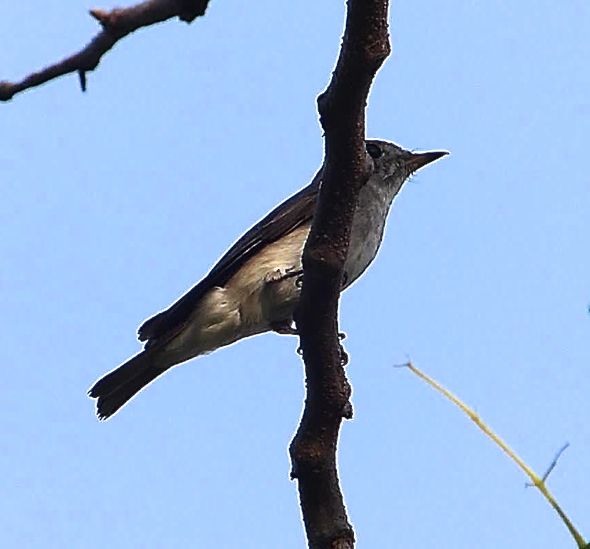“There is a Drumstick tree (Moringa oleifera) in my condo. Other than a hanging-parrot which was suspected to be a Blue-crowned Hanging-parrot (Loriculus galgulus) seen about two years ago, I have not noticed any other bird being attracted to this tree.
“About a month ago, however, I observed that the tree was in full bloom, with wilted flowers scattered all over the ground below the tree. While spending time to examine the intricate structure of the immature seedpods, I was surprised that there were a number of visitors to the plant.
“First there was an Asian Brown Flycatcher (Muscicapa dauurica) perching on a branch but apparently not actively looking out for prey (above). This is a winter visitor first seen around here three years ago. It flew off just a few seconds later.
“Then there were Olive-backed Sunbirds (Nectarinia jugularis) (both male as seen above and female) arriving to take nectar and foraging for insects, caterpillars etc. Olive-backed Sunbird, especially the male ones, frequently sing while foraging, this is evident from the edited video below. A Carpenter Bee (Xylocopa latipes), was seen joining the foraging party too.
“The video above include an episode of a male Olive-backed Sunbird manipulating and swallowing a prey that looked like a caterpillar. It lasted slightly under one and a half seconds. To enable better appreciation of the action, I have produced a frame-by-frame account of the episode which is shown below:
Sun Chong Hong
Singapore
19th March 2014
Note: Images above are screen grabs.



![SunbirdOB-drunstick fl [SunChongHong] - 1](https://besgroup.org/wp-content/uploads/SunbirdOB-drunstick-fl-SunChongHong-1.jpg)







5 Responses
Is this the same tree whose fruits are used in Indian cooking?
Yes. The leaves are an important source of protein, either dried and ground or used fresh as a vegetable. Indians love the pods, cooked with dahl. You chew the pod pieces, eat the seeds and spit out the fibres.
I’ve watched Tanimbar corella tearing up the dried pods to get at the seeds, leaving strips of empty pods scattered under the tree. Occasionally I was lucky to find two to 3 seeds still attached to a half bitten pod.
Thanks for the info. Dahl is one of my favourite foods, but none of my Indian friends knew the English name of this tree so I’ve always wondered if this was the plant they were talking about.
Wikipedia lists more uses of the plant.
http://en.wikipedia.org/wiki/Drumstick_tree